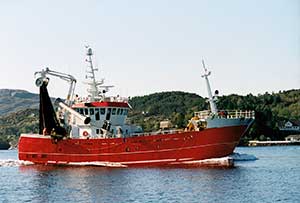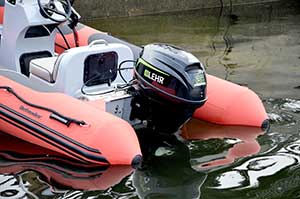Propane has the potential to establish marine market relevance

Commercial workboats are one entry to more propane gallons in the marine industry, but propane would likely play a role with the smaller vessels. Photo: iStock.com/ph2212
Propane-powered school buses and lawn mowers were concepts a decade ago. Now, a number of propane applications are available for those respective markets.
Could boats and ships be the next frontier for propane as a motor fuel?
“We see the benefits of the fuel and we are closely monitoring engine development and technology changes to see when the market is a little more ready and the opportunity is right,” says Tucker Perkins, chief business development officer at the Propane Education & Research Council (PERC).
Propane isn’t yet prevalent as a motor fuel in the U.S. recreational marine industry. Gasoline and diesel still dominate that space, but propane at least has a presence.
Marine outboard manufacturer Lehr, which brought another engine to market this year in a 25-horsepower model, has kept propane in the buying conversation among decision makers. The company also offers propane-powered outboard engines in horsepowers of 2.5, 5.0, 9.9 and 15.
But the market needs propane engines that consume more gallons to really take off, says Darren Engle, director of government relations at Blue Star Gas.
“Lehr has done a good job with the little outboard marine engines,” says Engle, whose company has multiple locations in the Northwest. “The challenge is that those don’t consume a lot of propane. The use doesn’t fit our premium-use profile because they’re utilizing smaller cylinders.”
Engle describes Blue Star Gas’ annual gallon sales derived from Lehr cylinders as “relatively small” and “almost unmeasurable.” He covets more gallons, but a number of things must come together for propane to be the viable marine fuel some envision.
“I do think we’re talking about a market that’s years away and not near-term ready,” Perkins says.
Competitive hurdles
The perception of propane among some people in the boating community is one issue at play. Small craft operators tend to be wary of propane, says Roger Marshall, a designer of power and sailing boats who owns Roger Marshall Yacht Design.
To gain larger entry to the marine market, propane stakeholders may have to sell decision makers on propane’s operational and safety advantages.
“Having used propane aboard many yachts and having a fire in one galley because the propane was left on, I think you’ll find that almost any sailor is very wary of propane,” Marshall says. “Standard wisdom is to turn off the propane at the tank when not in use. The ABYC (American Boat and Yacht Council) standard is for all propane lockers to be above the waterline and to be vented overboard.”
Marshall says liquefied natural gas (LNG) has a better future as a power source in the recreational marine industry. LNG is slowly gaining in use aboard yachts, he says, and sailors prefer it as an alternative to propane because it’s lighter than air.

Lehr offers propane engines in a variety of sizes, including this 25-horsepower model. Photo courtesy of Lehr
“Larger commercial shipping is only now being built with LNG-powered engines,” Marshall says. “My own feeling is that it will take five years or so before smaller engines are made for LNG.”
Aside from Lehr’s outboard engines, Marshall is not aware of any engines that use propane or LNG aboard small craft. Engle says LNG and compressed natural gas (CNG) proponents are currently exploring use of their fuels in the marine market.
“We know CNG and LNG are looking at it heavily,” Engle says. “They have challenges. They’re lighter than air, but their challenges are more in the Btu content of their fuel and the refueling applications.”
Refueling infrastructure is expensive for CNG and LNG, Engle adds. Developing CNG or LNG infrastructure for a marina is even more expensive than propane, he says.
“Propane infrastructure is more applicable,” Engle says. “I think CNG and LNG make more sense for ferries or those very large users where they can afford to put in that infrastructure.”
According to Perkins, the commercial workboat is propane’s gateway to boating-related gallon sales. PERC commissioned a 2013 study with ICF International, a market research firm that completed an analysis of the propane marine market. Perkins says ICF International’s research revealed that developing propane-powered workboats in the 100- to 150-horsepower range is essential to propane’s success and sustainability in the market.
Engle agrees with Perkins about propane’s best entry point to the marine market.
“We’re looking at getting into commercial fishing vessels that are on the water five or six days a week, eight to 10 hours a day, that are really utilizing fuel,” Engle says.
There is an estimated cutoff in horsepower where propane does not make sense, though.
“We don’t see propane having a vital role in the 1,000-horsepower market,” Perkins says. “Where we do see propane having a strong role is outboard engines and smaller commercial vessels – even tugs – that tend to stay in the continental U.S.”
Long road ahead
Although the propane industry has identified craft for the fuel, fuel system development is still needed. Engle says two approaches can be taken.
“One would be taking marinized engines and finding a fuel system for it,” he says. “The other system is taking a propane engine and marinizing it. I can see a place for both.”
Italy-based Power Sea Saver is one company that’s taken select marinized engines and developed kits that convert those engines to propane and gasoline. Company representative Rosanna Casamassima says Power Sea Saver has been offering its kits for several years. The kits, which utilize composite cylinders from Hexagon Ragasco’s Viking Cylinders, are available for engines as low as 25 horsepower to units as high as 400 horsepower.
“Our kit is also suitable for natural gas, and the engine will be able to run on gasoline and natural gas once a refueling solution for natural gas has been found,” Casamassima says. “With propane, it is easier as the solution we suggest because it’s a movable cylinder. This cuts off all the problems connected to an LPG pump at the pier.”
According to Casamassima, propane is a more viable option for Europe because of the expectation of new environmental regulations.
“Europe is going toward asking for [colored] marks on boats,” she says. “They do the same thing on cars. A green mark means your car is not polluting. A blue mark for the sea means your boat is not polluting and can sail in protected areas.”
Casamassima’s company has explored opportunities to expand in the U.S. Michigan-based Roush CleanTech has considered the opportunity, as well.
Blue Star Gas approached Roush a few years ago about developing a propane marine engine. Todd Mouw, vice president of sales and marketing at Roush CleanTech, says the marine market is one his company may eventually explore. Roush’s current focus is on-road vehicles.
“We really aren’t getting a ton of input from the market that people are looking to go propane [in the marine market] yet,” Mouw says. “That’s not to say that won’t happen.”
Additional obstacles
Other challenges remain to make propane a viable fuel for the marine market. On-board storage is one such challenge, according to Perkins.
“How are we going to store the appropriate amount of propane on board?” he says. “Today’s boats have fuel molded into the boat. It takes a completely different boat. There are no propane tanks molded into the hull, so we have to think about new ways for storing the fuel.”
Refueling is yet another challenge. Is this a cylinder exchange opportunity or one better suited for dispensers?
“We recognize all these issues now discussing these marketplaces,” Perkins says. “When we were first doing a lot of this, we talked about technology and how to get it into equipment. Now we’re thinking through the whole chain. What equipment will it be in? What are the codes and standards? What’s the margin benefit?
“All of those things look good in the marine market,” he adds. “It’s just that the market is not quite mature enough for us to invest in heartily.”
U.S. Coast Guard codes and standards also must develop before propane entrenches itself more in the marine market, Perkins says.
“The codes and standards for marine use of propane are not always clear, or even the applicability of certain codes has not been agreed on by all authorities with jurisdiction,” he says. “Our meetings with the U.S. Coast Guard brought agreement that once they finished the initial body of work on LNG and CNG in vessels, they would work with the LPG industry and include LPG in that work.
“In their view, this initial work was about oceangoing vessels, [for] which we don’t see a propane-fueled market,” Perkins adds. “But eventually, this work moves to workboats and ferries.”
NFPA 58 is still the principal code for programs confined to outboards and dispensers, Perkins says.
“As we venture into larger engines, perhaps inboards and consider onboard built-in fuel tanks, and ferries or workboats, then the Coast Guard has jurisdiction and we need clearer standards,” he says.
















